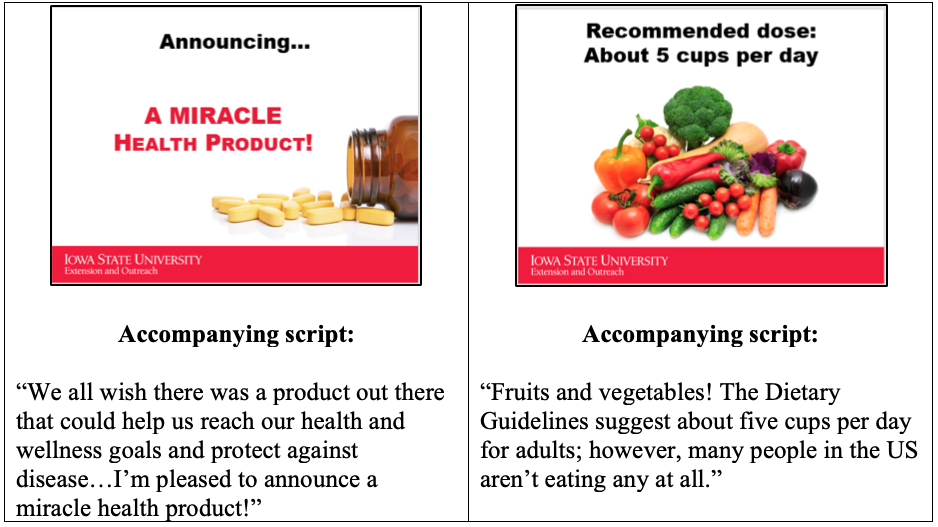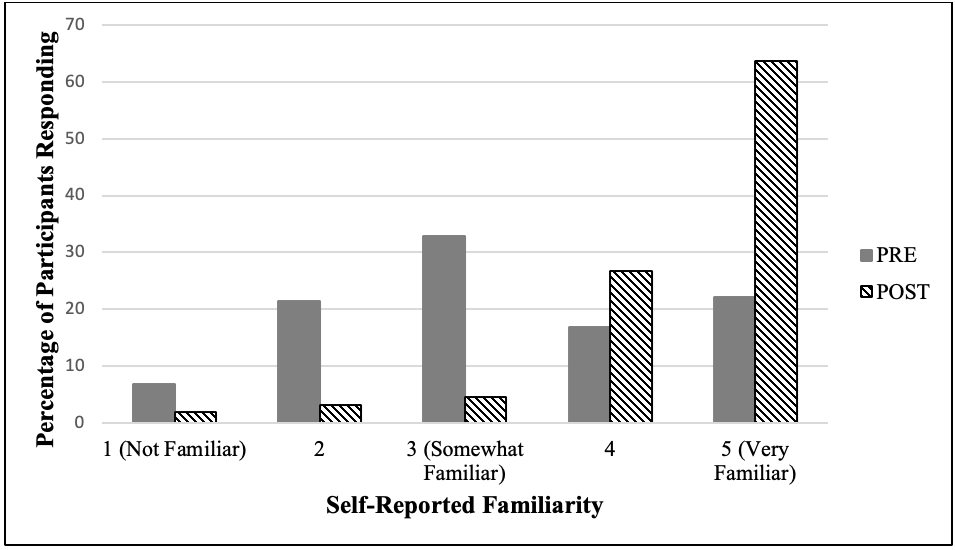 |
December 2019
|
December 2019 // Volume 57 // Number 6 // Tools of the Trade // v57-6tt4
Veg Out! Use of an Infomercial-Style Format in a Produce Awareness Program
Abstract
Veg Out! is an infomercial-style produce awareness session. We use image-focused rather than content-focused slides to highlight the health benefits associated with produce consumption. This image-focused approach is helping participants become more familiar with produce serving sizes and increasing the likelihood of their consuming more produce. Our findings suggest that an image-focused education session is an effective strategy for promoting familiarity with the topic being presented and increasing the likelihood of behavior change.
Introduction
Nationally, 87.8% and 90.7% of adults do not meet recommendations for daily fruit intake and daily vegetable intake, respectively (Centers for Disease Control and Prevention, 2018). In Iowa, specifically, 41.7% and 26.9% of adults report eating fruit and vegetables, respectively, less than once daily (Iowa Department of Public Health, 2016).
Common barriers to eating produce include cost, preparation time, and lack of access (Haynes-Maslow, Parsons, Wheeler, & Leone, 2013). These barriers adversely affect an individual's ability to consume the recommended amount of produce daily. Historically, Extension has addressed this issue through sequential multiweek produce-focused programs effective in increasing produce intakes (Cason, 2005; Jones, Lynch, & Schnepf, 2007) and improving knowledge of produce health benefits (McClelland, Jayaratne, & Bird, 2013). Although Extension typically prefers sequential multiweek programs, in Iowa we are experiencing an increased customer demand for one-session programs. Therefore, we chose to develop a one-session infomercial-style produce lesson to meet this demand.
Veg Out! Program Description
Our goal with the program Veg Out! is to encourage produce consumption among adults aged 18 years and older by emphasizing the health benefits of fruits and vegetables, discussing barriers to consumption, and encouraging participants to set the goal of consuming 5 cups daily. The 5-cups-a-day recommendation is based on general MyPlate recommendations for men (3 cups vegetables, 2 cups fruit daily) as well as the ranges of recommended intakes presented in the 2015 Dietary Guidelines (U.S. Department of Health and Human Services and U.S. Department of Agriculture, 2015). The produce intake recommendations for women are slightly lower. However, because there are no documented adverse effects to eating somewhat more than the recommended amount of produce, we chose to focus on the easy-to-remember message of "5 cups of fruits and vegetables daily."
Veg Out! is structured as a short session (60 min or less) that can be delivered in group settings or at an interactive information booth. We incorporated many recommendations for improving health literacy in the presentation design (Niebaum, Cunningham-Sabo, & Bellows, 2015), including
- limiting the number of health messages,
- using positive messaging,
- incorporating short words and phrases,
- limiting the use of jargon, and
- using visually appealing slides.
The session presentation is not content-focused but image-focused to enhance health literacy concerning produce recommendations. Health literacy is the "ability to obtain, process and understand basic health information and services to make appropriate health decisions" (U.S. Department of Health and Human Services, 2008, "Introduction," para. 1). An image-based format results in positive learning effects such as self-care behaviors and understanding of recommendations (Jungmin & Zuniga, 2016). Figure 1 shows examples of the image-focused slides with the corresponding script text.
Figure 1.
Examples of Veg Out! Presentation Slides

We designed the presentation to build excitement for the "miracle health product" that slide one promotes, as infomercials do. For example, the first several slides include text identifying common benefits associated with produce consumption (e.g., lowered cancer risk) and are accompanied by short corresponding scripts (e.g., "Yes, there is a simple product you can take that can reduce your risk of getting certain cancers"). The slides do not provide in-depth explanations (e.g., how produce reduces cancer risk), as a more traditional presentation would.
Veg Out! is implemented throughout Iowa by nutrition and wellness specialists. In addition to the infomercial-style presentation, program facilitators provide audience members the opportunity to taste the recipe Whole Meal Salad from the Spend Smart Eat Smart website (https://spendsmart.extension.iastate.edu/recipe/whole-meal-salad/). We used this recipe because it provides an affordable and nutritious way to include more vegetables in one's diet.
Participants also are guided through a handout on the benefits of eating a variety of produce, serving sizes, strategies for overcoming barriers to consumption, and a goal-setting activity. Additionally, participants can acquire supplemental materials that address their individual barriers to increased produce consumption. For example, if they perceive that they cannot afford fruits and vegetables, they can pick up brochures about food assistance or food pantries.
The interactive information booth is used at health fairs and offers only the tasting and supplemental materials. No in-depth discussion is provided.
To ensure consistent statewide delivery of the program via Extension, we included in the Veg Out! curriculum the following standardized materials:
- PowerPoint presentation with corresponding script,
- Veg Out! promotional flyers,
- program evaluation form (see appendix), and
- Veg Out! Program Guide, a document that describes the resources needed for program delivery and includes a general program instruction list.
Program Evaluation
Following delivery of each session, participants complete an evaluation. The evaluation form consists of six questions addressing participants' sociodemographics, general understanding of produce health benefits, familiarity with produce serving sizes before and after the session, and likelihood of consuming produce daily after participating in the session.
We examined evaluation results from July 2016 to May 2019. We entered responses from the paper evaluations completed by 275 group session participants into a corresponding online Qualtrics survey and then converted the results to SPSS for statistical analyses. Evaluation forms from eight respondents who did not provide their ages and five who were under age 18 were excluded from our analyses; thus, the total sample was 262 participants.
Descriptive statistics were used for participants' sociodemographic data, understanding of health benefits, and likelihood of increasing produce intake. Change from preprogram familiarity with produce serving sizes to postprogram familiarity was assessed using the Wilcoxon signed-rank test. Iowa State University's Institutional Review Board reviewed the study protocol and designated the study as exempt.
Participant demographic data are shown in Table 1. Almost all participants (96.6%) correctly stated that daily produce consumption offers multiple health benefits. Participants' familiarity with produce serving sizes significantly increased (p ≤ .0001) after attending the session, with the percentage of those stating that they were "very familiar" with serving size increasing from 22.1% to 63.6% (Figure 2). Finally, over half (55.6%) stated that they were "very likely" to eat produce daily after the Veg Out! session (Figure 3).
| Characteristic (number of responses) | Number | Percentage |
|---|---|---|
| Age (262 responses) | ||
| 18-25 | 27 | 10.3 |
| 26-34 | 43 | 16.4 |
| 35-44 | 36 | 13.7 |
| 45-54 | 24 | 9.2 |
| 55-64 | 55 | 21.0 |
| 65-74 | 49 | 18.7 |
| 75-plus | 28 | 10.7 |
| Gender (259 responses) | ||
| Female | 220 | 84.9 |
| Male | 39 | 15.1 |
Figure 2.
Participants' Familiarity with Produce Serving Sizes Before (Pre) and After (Post) Veg Out! Session

Figure 3.
Participants' Likelihood of Eating Produce After Veg Out! Session

Summary
Our findings indicate the infomercial-style format of Veg Out! is effective for increasing participants' familiarity with produce serving sizes and their likelihood of consuming 5 cups of produce daily.
Infomercial-style programs can be effective in producing measurable change and can be useful when promoting Extension as a research-based nutrition resource. To ensure the effectiveness of these programs, we suggest that
- the message be clear and concise,
- the program materials be standardized for statewide delivery, and
- an evaluation tool be used to measure impact.
References
Cason, K. L. (2005). Effectiveness of a program to increase fruit and vegetable consumption. Journal of Extension, 43(4), Article 4IAW2. Available at: https://www.joe.org/joe/2005august/iw2.php
Centers for Disease Control and Prevention. (2018). State indicator report on fruits and vegetables, 2018. Retrieved from https://www.cdc.gov/nutrition/downloads/fruits-vegetables/2018/2018-fruit-vegetable-report-508.pdf
Haynes-Maslow, L., Parsons, S. E., Wheeler, S. B., & Leone, L. A. (2013). A qualitative study of perceived barriers to fruit and vegetable consumption among low-income populations, North Carolina, 2011. Preventing Chronic Disease, 10(3), E34.
Iowa Department of Public Health. (2016). Health in Iowa annual report from the Iowa 2015 Behavioral Risk Factor Survey. Retrieved from http://idph.iowa.gov/Portals/1/Files/BRFSS/2015%20Annual%20BRFSS%20Report.pdf
Jones, G., Lynch, P., & Schnepf, M. (2007). Sisters together—Program increases fruit and vegetable consumption and physical activity of African American women. Journal of Extension, 45(4), Article 4IAW1. Available at: https://www.joe.org/joe/2007august/iw1.php
Jungmin, P., & Zuniga, J. (2016) Effectiveness of using picture-based health education for people with low health literacy: An integrative review. Cogent Medicine, 3(1). https://doi.org/10.1080/2331205X.2015.1264679
McClelland, J. W., Jayaratne, K. S. U., & Bird, C. (2013). Nutrition education brings behavior and knowledge change in limited-resource older adults. Journal of Extension, 51(2), Article 2FEA1. Available at: https://www.joe.org/joe/2013april/a1.php
Niebaum, K., Cunningham-Sabo, L., & Bellows, L. (2015). Developing effective educational materials using best practices in health literacy. Journal of Extension, 53(4), Article 4TOT2. Available at: https://www.joe.org/joe/2015august/tt2.php
U.S. Department of Health and Human Services. (2008). America's health literacy: Why we need accessible health information (Issue brief). Retrieved from https://health.gov/communication/literacy/issuebrief/
U.S. Department of Health and Human Services and U.S. Department of Agriculture (2015). 2015–2020 dietary guidelines for Americans (8th ed.). Retrieved from https://health.gov/dietaryguidelines/2015/guidelines/
Appendix
Veg Out! Program Evaluation
Please answer the following questions:
| Not at all familiar | Very familiar | |||
|---|---|---|---|---|
| 1 | 2 | 3 | 4 | 5 |
| Not at all familiar | Very familiar | |||
|---|---|---|---|---|
| 1 | 2 | 3 | 4 | 5 |
| Not likely | Very likely | |||
|---|---|---|---|---|
| 1 | 2 | 3 | 4 | 5 |




